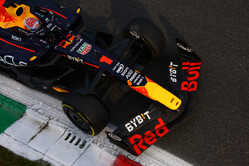


14/09/2023
NEWS STORY
 Finally the FIA appears to be listening to drivers and fans as the 2026 rules overhaul is likely to see cars lighter and smaller.
Finally the FIA appears to be listening to drivers and fans as the 2026 rules overhaul is likely to see cars lighter and smaller.
The current cars are among the biggest and heaviest in the entire history of the sport, 203 kgs heavier than their 2008 counterparts - the year before KERS was first introduced - and 156 kgs heavier than in 2013, the year before the sport went hybrid.
Fernando Alonso, whose debut in 2001 was at the wheel of a Minardi that weighed in at 595 kgs, has previously argued that car dimensions are also an issue, that Minardi being 1.796 metres wide and 4.445 metre long while his current Aston Martin is 2 metres wide and 5.5 metres long.
"I don't think it would change much," said the Spaniard when asked earlier this year if reducing the weight would improve the show and make the cars more enjoyable to drive. "I think it's more the size of the cars than the weight which makes things a little bit more difficult, overtaking, fights into the first couple of corners of a race, it is difficult now to position the car, just because of the size of it, not because of the weight.
"I think it's going to be really difficult to significantly reduce the weight because of the hybrid engines," he added, "which will always be heavier than normal engines, and the safety on these cars is a lot higher as well.
"It's always more fun to drive light cars," he admitted. "But at the end of the day, it's more the size of them that makes racing a little bit more difficult."
However, in terms of safety, GPDA director, George Russell is more concerned at the sheer weight of the current cars.
"Obviously the heavier you make them when you have an impact it's like crashing with a bus compared to a smart car," he said. "You're going to have a greater impact if you're going the same speed with a car that weights 800-odd-kgs or over 900 kgs at the start of a race, compared to one 15 years ago when they were at 650 kg."
Nikolas Tombazis, the FIA's head of single-seaters, has admitted that making the cars lighter and smaller is one of the priorities as the sport looks ahead to the 2026 rules overhaul.
"With the dimensions of the wheels, which will be narrower, plus with the rear wing and the car in general, we aim to reduce the weight of the cars by around 50kg," he told Motorsport.com's Italian outlet. "So, it will be possible to see smaller single-seater cars: shorter and narrower. But we are talking about solutions that still need to be discussed.
"With the car on a diet, we will be able to reduce the cornering speeds a bit," he added. "Being lighter, they will go faster in a straight line, but will generate less aerodynamic load. So, we will need to increase the hybrid's energy recovery to ensure adequate lap performance.
"A lot of work has been done to understand how energy recovery and management will have to be done, and how overtaking can be done based on the aerodynamic configuration. We have carried out many simulations by changing these parameters and we have found solutions that seem to work adequately."
However, having experienced the proposed 2026 regulations in the simulator, Max Verstappen was left less than impressed, the two-time world champion describing the experience as "terrible".
"If you go flat-out on the straight at Monza, I don't know what it is, like four or five hundred metres before the end of the straight, you have to downshift flat-out, because that's faster. I think that's not the way forward, but of course, probably that's one of the worst tracks.
"The cars probably have a lot less drag," he added, "so it will be even harder to overtake on the straight. You have the active aerodynamics, which you can't control, the system will control it for you. Which then I think makes it very awkward to drive, because I prefer to control it myself.
"Of course, when you're behind someone, maybe you need more front or more rear. These kind of things. If the system starts to control that for you, I don't think that's the right way forward.
"We have to seriously look at this because '26 is not that far away," he warned. "At the moment, to me, it looks very bad from all the numbers and what I see from the data already. So it's not something I'm very excited about at the moment."
"If one took the 2026 power units and mounted them on the current cars, probably the result would be the scenario put forward by those who were worried," insists Tombazis. "But in recent months, we have collected a series of very positive developments, so the comments express old positions.
"We also need to take into account that the engine and chassis will have to evolve together, and it will not be possible to think of one without the other."